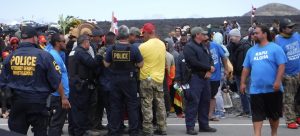The Impossibility of Consent and Other Problems on Mauna Kea
By Greg Johnson

This post pertains to the Thirty Meter Telescope project on Mauna Kea (Hawai`i), which the author has written about on this forum previously. For important background and analysis of the dispute, see this forum in Radical History Review.
The Thirty Meter Telescope (TMT) project proposed for construction on Mauna Kea (Hawai`i) has provoked more than a decade of legal, political, and cultural resistance from many Native Hawaiians, including widely mediatized direct action protests. This resistance has pushed the project into significant cost overruns. In an attempt to secure further funds, the project is now seeking U.S. federal support through the National Science Foundation (NSF). Such funding is contingent upon federal environmental and cultural review processes pursuant to the National Environmental Policy Act (NEPA) and the National Historic Preservation Act (NHPA). As an initial step in these review processes, the NSF conducted scoping meetings in Hawai`i this past summer (2022) and solicited written feedback on their proposed plans.
The remainder of this post is a redacted and abridged version of my comments responsive to this request, which are based on involvement in the dispute since 2015. While specific to the TMT context, these comments point to issues of broad concern at the intersection of development projects, science, and Indigenous well-being. One goal in sharing my comments is to offer a concrete example of scholar/activist interventions in such processes in hopes of prompting further discussion on the topic of public engagement and the humanities.
1) Absence of consent. Absence of consent is the largest issue the TMT project faces. In terms of scoping, what is the NSF’s proposed method for seeking and assessing consent? By what metric does the NSF intend to measure consent? As you are aware, free, prior, and informed consent (FPIC) is the international standard for research and development projects concerning Indigenous peoples. This standard is articulated in the United Nations Declaration on the Rights of Indigenous Peoples (UNDRIP), to which the U.S. is a signatory.
If the NSF affirms the moral imperative of seeking and obtaining Native Hawaiian consent for the TMT project, then you will be positioned to regain the goodwill of the community and secure reputational standing for future endeavors in Hawai`i. However, the cost of affirming the standard of consent entails recognizing the categorical impossibility of receiving it. In addition to the extremely difficult task of persuading a majority of Native Hawaiians to support the project, and unlike the case with many Native American tribes and nations, there is no political entity that represents Native Hawaiian interests in a way that can confer consent. It is not the fault of the NSF that this is the lay of the land. The historical frame has been set.
In the alternative, the NSF could admit that the ethical standard of consent is out of its reach and proceed nonetheless. If that path is taken, then the NSF will be operating in a manner decades out of touch with best practices. Surely it is not in the interest of the NSF to trade against the very standard it expects of the researchers it supports. Practically speaking, if consent is not the standard NSF aspires to, the community will detect this immediately. You will be left speaking the pale language of consultation. If the NSF adopts this time-worn idiom and trajectory, your traction will be less than zero as you actively foment sentiments of frustration and resolve that will animate future rounds of protest.
2) Institutional ethics and accountability. The second issue I wish to address is one in which I have a personal stake. My employer, the University of California (UC), is one of the lead entities driving the TMT project. I have grave ethical concerns about UC being involved in a project that is fundamentally at odds with Native Hawaiian interests.
Additionally, I have fiscal concerns about the use of university funds for this project. Specifically, I am convinced that Native Hawaiians will continue to challenge this project, including through direct action, which will cause the cost of the project to escalate continuously. In this environment, I seriously doubt TMT will ever be successfully completed and operational on Mauna Kea. The finite resources of the UC system should not be squandered in this manner. The only foreseeable path to TMT’s completion on Mauna Kea will entail dramatically upscaled state reactions to protests, including the use of force. I am frankly horrified by the specter of my university being a primary sponsor of a project that may require the use of force against Native Hawaiians.
3) Living tradition. My third scoping point concerns scoping for the vitality of contemporary traditional expressions. Previous environmental and cultural assessments for the TMT project have defaulted to archeological studies and stale cultural evaluations drawn from small and dated samples. Embedded in these reviews is a reification of the fifty-year-old or older standard that haunts cultural assessment instruments, methods, and outcomes. Standards in scholarly communities have shifted considerably on the question of what can and should count as “tradition.” Whether in anthropology, Native studies, or religious studies, among other fields, scholars now take it as given that tradition is processual and meaningful reckoning of it must include the unfolding present. This comports with guidance provided by Native communities.
In terms of scoping, I urge the NSF to take a leadership role in foregrounding living tradition in its assessments. Listening to the voices of the community is crucial, of course. But listening to them as the bearers of tradition is what will set a new standard. Commission sustained ethnographic work with people who participated in the protection movements of 2015 and 2019 to fathom how their commitments stem from deeply held and sincere religious convictions. Consider how the thrice-daily ceremonies during the protest of 2019–2020 were not only evidence of cultural life but are a source of it. In other words, challenge your scoping process to be capacious enough to see the generative quality of cultural life on Mauna Kea.
4) Political and sincere. Finally, I urge the NSF to abandon a particularly problematic assessment framework that shaped the contested case findings of 2016–2017 and the State Supreme Court ruling of 2018 affirming TMT’s construction permit. This dubious framework is one wherein the appearance of political motivations is taken to be sufficient evidence that an act is not sincerely religious or cultural and therefore not adequate to trigger administrative or legal protection.
Scholars of religion have long acknowledged that all religion is political insofar as all religious life is of this social world, no matter how much it may refer to other dimensions and realities. There is no moment in the history of any tradition that stands outside of this condition. Broadly speaking, the political context of religious life is always on a spectrum, sometimes pressing and visible, other times muted and submerged. In short, political realities, especially concerning boundaries of group belonging and group persistence, are ever-present in religious life. If the NSF adopts the model of dismissing religious or cultural actions when they take place in apparently political contexts, then any pretense of conducting intellectually sound assessments should be abandoned. Actions should be assessed in context, of course, but they should not be discriminated against prima facie because of their context. If the NSF scopes for religious life in-and-as political expression, it will gain a richer view of Native Hawaiian tradition.
#
Greg Johnson is Professor of Religious Studies and Director of the Walter H. Capps Center for the Study of Ethics, Religion, and Public Life at the University of California, Santa Barbara, an institution directly implicated in the Mauna Kea dispute. He visited the encampments on Mauna Kea several times in 2015 and 2019 and was a witness for intervenor William Freitas in the contested case (2016–2017).
Counterpoint blogs may be reprinted with the following acknowledgement: “This article was published by Counterpoint: Navigating Knowledge on 24 October 2022.”
The views and opinions expressed on this website, in its publications, and in comments made in response to the site and publications are those of the author(s) and do not necessarily reflect the views and opinions of Counterpoint: Navigating Knowledge, its founders, its staff, or any agent or institution affiliated with it, nor those of the institution(s) with which the author is affiliated. Counterpoint exists to promote vigorous debate within and across knowledge systems and therefore publishes a wide variety of views and opinions in the interests of open conversation and dialogue.
Photo credits: “Kia`i (protectors) and police engage prior to arrests on Mauna Kea (July, 2019).” © Greg Johnson, 2019.



